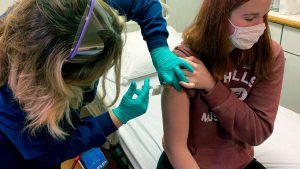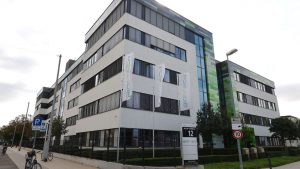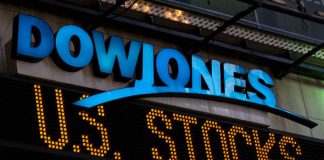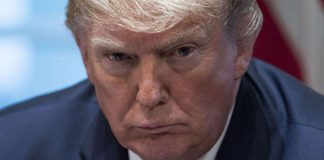NOVEMBER 9, 2020

A volunteer in Pfizer’s clinical trial was vaccinated this month at Cincinnati Children’s Hospital Medical Center. – Cincinnati Children’s Hospital Medical Center, via AP
The drug maker Pfizer announced on Monday that an early analysis of its coronavirus vaccine trial suggested the vaccine was robustly effective in preventing Covid-19, a promising development as the world has waited anxiously for any positive news about a pandemic that has killed more than 1.2 million people.
Pfizer, which developed the vaccine with the German drugmaker BioNTech, released only sparse details from its clinical trial, based on the first formal review of the data by an outside panel of experts.
The company said that the analysis found that the vaccine was more than 90 percent effective in preventing the disease among trial volunteers who had no evidence of prior coronavirus infection. If the results hold up, that level of protection would put it on par with highly effective childhood vaccines for diseases such as measles. No serious safety concerns have been observed, the company said.

BioNTech’s headquarters in Mainz, Germany. – Kai Pfaffenbach/Reuters
Pfizer plans to ask the Food and Drug Administration for emergency authorization of the two-dose vaccine later this month, after it has collected the recommended two months of safety data. By the end of the year it will have manufactured enough doses to immunize 15 to 20 million people, company executives have said.
“This is a historical moment,” Kathrin Jansen, a senior vice president and the head of vaccine research and development at Pfizer, said in an interview. “This was a devastating situation, a pandemic, and we have embarked on a path and a goal that nobody ever has achieved — to come up with a vaccine within a year.”
Independent scientists have cautioned against hyping early results before long-term safety and efficacy data has been collected. Still, the development makes Pfizer the first company to announce positive results from a late-stage vaccine trial, vaulting it to the front of a frenzied global race that began in January and has unfolded at record-breaking speed.
Eleven vaccines are in late-stage trials, including four in the United States. Pfizer’s progress could bode well for Moderna’s vaccine, which uses similar technology. Moderna has said it could have early results later this month.
The news comes just days after Joseph R. Biden Jr. clinched a victory over President Trump in the presidential election. Mr. Trump had repeatedly hinted a vaccine would be ready before Election Day, Nov. 3. This fall, Pfizer’s chief executive, Dr. Albert Bourla, frequently claimed that the company could have a “readout” by October, something that did not come to pass.
Operation Warp Speed, the federal effort to rush a vaccine to market, has promised Pfizer $1.95 billion to deliver 100 million doses to the federal government, which will be given to Americans free of charge. But Dr. Jansen sought to distance the company from Operation Warp Speed and presidential politics, noting that the company — unlike the other vaccine front-runners — did not take any federal money to help pay for research and development.
“We were never part of the Warp Speed,” she said. “We have never taken any money from the U.S. government, or from anyone.”
She said she learned of the results from the outside panel of experts shortly after 1 p.m. on Sunday, and that the timing was not influenced by the election. “We have always said that science is driving how we conduct ourselves — no politics,” she said.
The data released by Pfizer Monday was delivered in a news release, not a peer-reviewed medical journal. It is not conclusive evidence that the vaccine is safe and effective, and the initial finding of more than 90 percent efficacy could change as the trial goes on.
Dr. Jansen said that because the trial is continuing, an independent board reviewing the data has not told her or other company executives other details, such as how many of the people developed mild versus more severe forms of Covid-19 — crucial information that the F.D.A. has said it will need to evaluate any coronavirus vaccine. The agency has also asked for other detailed data that could take weeks to review, including about how the company plans to manufacture millions of doses and ensure that the product is consistent and safe.
The trial is expected to continue until 164 people in the 44,000 person trial have developed Covid-19, and will also evaluate how well it protects against developing severe forms of the disease, and how well the vaccine protects people who have already been infected with the coronavirus.
Half of the participants received two doses of the vaccine, and half received a placebo. The first analysis was based on 94 volunteers who developed Covid-19. Dr. Jansen said the outside board did not say how many of those cases came from participants who had been vaccinated. But with a rate of more than 90 percent effectiveness, most had to have been in the placebo group.
Dr. Jansen said the global surge in coronavirus infections contributed to the speed with which participants in the trial got infected with the virus. “You can see for yourself, the rates are going up everywhere,” she said. “So we think based on our predictions, it shouldn’t take us very long” to get to 164 cases of Covid-19.
Work on the vaccine began in Mainz, Germany, in late January, when Ugur Sahin, the chief executive and co-founder of BioNTech, read about the virus in the Lancet that filled him with dread. “I almost instantly knew that this would affect us,” Mr. Sahin said in an interview. That same day, the first European cases were detected, in France.
Mr. Sahin assembled a 40-person team to work on the vaccine. Many employees canceled vacations and Mr. Sahin authorized overtime pay. They called it Project Lightspeed.
BioNTech used a technology that had never been approved for use in people. It takes genetic material called messenger RNA and injects it into muscle cells, which treat it like instructions for building a protein — a protein found on the surface of the coronavirus. The proteins then stimulate the immune system and are believed to result in long-lasting protection against the virus. Other companies, including Moderna, are also using messenger RNA technology.
BioNTech quickly identified 20 vaccine candidates, and began testing them on rodents. But the company lacked the experience and resources to rapidly conduct a major clinical trial. So Mr. Sahin called Pfizer. The two companies had been working to develop a flu vaccine since 2018, and within a day of Mr. Sahin calling Dr. Jansen at Pfizer, the companies agreed to partner on a coronavirus vaccine. In mid-March, the companies announced their partnership.
After early human trials, they determined that two vaccine candidates produced a robust immune response, including antibodies against the virus and powerful immune cells known as T cells. They chose the one with fewer side effects to start a trial with more than 30,000 volunteers in the U.S., Argentina, Brazil and Germany. In September the company expanded the trial to 44,000 participants.
Even before it began, the Trump Administration placed a bet that Pfizer and BioNTech would succeed, announcing its advance purchase deal on July 22. At the time, it was the largest such commitment from the U.S. government.
From time to time over the past seven months, while working from his home in the affluent suburb of Scarsdale, New York, Dr. Bourla spoke with Mr. Trump, who had tied progress on a vaccine to his election hopes. Dr. Bourla said the president pressed for details about when the vaccine might be ready.
“Every time I spoke with the president I told him that he should not worry about us compromising safety or efficacy, but that we would do it as quickly as science allows us,” he said.
Late this summer, as the president made public pronouncements about a vaccine coming soon, Dr. Bourla boarded a Pfizer jet to Frankfurt to pick up Mr. Sahin. The two men were meeting face-to-face for the first time, but there was little time for pleasantries, or even science.
As they descended toward a factory in Austria that would produce their vaccine, they discussed how to ensure a wary public would trust their vaccine. Days later, Pfizer organized an effort by major drug companies to pledge that any coronavirus vaccine would stand up to scientific scrutiny.
In another move to shore up public confidence and after criticism from outside researchers, Pfizer and other companies took the unusual step of releasing their trial blueprints, known as protocols, revealing typically secret details about how it was evaluating its vaccine.
Two days after Mr. Trump called out Pfizer by name in the first presidential debate, saying it and other vaccine makers were being hampered by politics, Dr. Bourla emailed Pfizer employees.
“We are approaching our goal,” he wrote. “And despite not having any political considerations with our pre-announced date, we find ourselves in the crucible of the U.S. Presidential election.”
The trial’s protocol allowed four interim analyses — early looks that would give the outside board of experts a chance to identify safety concerns, and assess whether the vaccine was working. Outside of this panel, no one — not doctors or company officials — were allowed to know which participants received the vaccine or a placebo.
The first interim analysis was supposed to have taken place after 32 people in the study developed Covid-19, but the company said that, after discussing the matter with the F.D.A., it decided to wait until the second analysis — at 62 cases. During its discussions with the agency, 32 additional cases quickly accrued.
“When everything was done and dotted, and we could actually do the analysis, it turned out we had even far more than what we expected,” Dr. Jansen said. So the outside panel reviewed 94 cases — more than half the number needed to complete the trial.
Wide distribution of Pfizer’s vaccine will be a logistical challenge. Because it is made with mRNA, the doses will need to be kept at ultra cold temperatures. While Pfizer has developed a special cooler to transport the vaccine, equipped with GPS-enabled thermal sensors, it remains unclear where people will receive the shots, and what role the government will play in distribution. Adding to the challenge, people will need to return three weeks later for a second dose to complete the immunization.
Most experts say the world will need many treatments and vaccines to bring an end the pandemic.
“There’s a lot at stake for humanity,” Dr. Bourla said. “If we get it right, the world can be saved.”
Courtesy/Source: NY Times










































































































